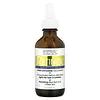What's inside
What's inside
 Key Ingredients
Key Ingredients

 Benefits
Benefits

 Concerns
Concerns

 Ingredients Side-by-side
Ingredients Side-by-side

Water
Skin ConditioningIsopropyl Myristate
EmollientGlycerin
HumectantPyrus Malus Fruit Extract
Skin ConditioningEthylhexyl Olivate
Skin ConditioningCetearyl Alcohol
EmollientAloe Barbadensis Leaf Juice
Skin ConditioningSqualane
EmollientCopernicia Cerifera Cera
EmollientRetinol
Skin ConditioningPropanediol
SolventSodium Cocoamphoacetate
CleansingTocopheryl Acetate
AntioxidantBHT
AntioxidantBHA
AntioxidantXanthan Gum
EmulsifyingOryza Sativa Bran Extract
Skin ConditioningRosmarinus Officinalis Leaf Extract
AntimicrobialHelianthus Annuus Extract
EmollientTocopherol
AntioxidantCyamopsis Tetragonoloba Gum
Emulsion StabilisingAvena Sativa Bran Extract
AbrasiveCitrus Aurantium Dulcis Peel Extract
Emulsion StabilisingCamellia Sinensis Leaf Extract
AntimicrobialTetrasodium Glutamate Diacetate
Ammonium Acryloyldimethyltaurate/Vp Copolymer
Citric Acid
BufferingParfum
MaskingPhenoxyethanol
PreservativeMaltodextrin
AbsorbentCaprylyl Glycol
EmollientEthylhexylglycerin
Skin ConditioningHexylene Glycol
EmulsifyingButylphenyl Methylpropional
PerfumingLinalool
PerfumingLimonene
PerfumingCitronellol
PerfumingWater, Isopropyl Myristate, Glycerin, Pyrus Malus Fruit Extract, Ethylhexyl Olivate, Cetearyl Alcohol, Aloe Barbadensis Leaf Juice, Squalane, Copernicia Cerifera Cera, Retinol, Propanediol, Sodium Cocoamphoacetate, Tocopheryl Acetate, BHT, BHA, Xanthan Gum, Oryza Sativa Bran Extract, Rosmarinus Officinalis Leaf Extract, Helianthus Annuus Extract, Tocopherol, Cyamopsis Tetragonoloba Gum, Avena Sativa Bran Extract, Citrus Aurantium Dulcis Peel Extract, Camellia Sinensis Leaf Extract, Tetrasodium Glutamate Diacetate, Ammonium Acryloyldimethyltaurate/Vp Copolymer, Citric Acid, Parfum, Phenoxyethanol, Maltodextrin, Caprylyl Glycol, Ethylhexylglycerin, Hexylene Glycol, Butylphenyl Methylpropional, Linalool, Limonene, Citronellol
 Reviews
Reviews

Ingredients Explained
These ingredients are found in both products.
Ingredients higher up in an ingredient list are typically present in a larger amount.
Glycerin is already naturally found in your skin. It helps moisturize and protect your skin.
A study from 2016 found glycerin to be more effective as a humectant than AHAs and hyaluronic acid.
As a humectant, it helps the skin stay hydrated by pulling moisture to your skin. The low molecular weight of glycerin allows it to pull moisture into the deeper layers of your skin.
Hydrated skin improves your skin barrier; Your skin barrier helps protect against irritants and bacteria.
Glycerin has also been found to have antimicrobial and antiviral properties. Due to these properties, glycerin is often used in wound and burn treatments.
In cosmetics, glycerin is usually derived from plants such as soybean or palm. However, it can also be sourced from animals, such as tallow or animal fat.
This ingredient is organic, colorless, odorless, and non-toxic.
Glycerin is the name for this ingredient in American English. British English uses Glycerol/Glycerine.
Learn more about GlycerinTocopherol (also known as Vitamin E) is a common antioxidant used to help protect the skin from free-radicals and strengthen the skin barrier. It's also fat soluble - this means our skin is great at absorbing it.
Vitamin E also helps keep your natural skin lipids healthy. Your lipid skin barrier naturally consists of lipids, ceramides, and fatty acids. Vitamin E offers extra protection for your skin’s lipid barrier, keeping your skin healthy and nourished.
Another benefit is a bit of UV protection. Vitamin E helps reduce the damage caused by UVB rays. (It should not replace your sunscreen). Combining it with Vitamin C can decrease sunburned cells and hyperpigmentation after UV exposure.
You might have noticed Vitamin E + C often paired together. This is because it is great at stabilizing Vitamin C. Using the two together helps increase the effectiveness of both ingredients.
There are often claims that Vitamin E can reduce/prevent scarring, but these claims haven't been confirmed by scientific research.
Learn more about TocopherolWater. It's the most common cosmetic ingredient of all. You'll usually see it at the top of ingredient lists, meaning that it makes up the largest part of the product.
So why is it so popular? Water most often acts as a solvent - this means that it helps dissolve other ingredients into the formulation.
You'll also recognize water as that liquid we all need to stay alive. If you see this, drink a glass of water. Stay hydrated!
Learn more about Water